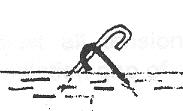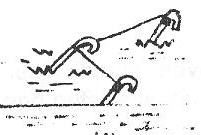Tent - Pitching

Camping is one of the regular
activities of the
NPCC. Campers stay in tents at Annual Camps and Adventure Training Camps at the
NPCC campsite in Pulau Ubin. Hence, it is necessary for instructors and cadets
to familiarize themselves with tent - pitching. Besides, tent - pitching is also
important in Campcraft Competitions that is held by the NPCC HQ once every 2
years.
Parts of the NPCC 4-man tent
- 1 x inner sheet (with flaps at both ends and
walls on both sides)
- 1 x outer sheet
- 1 x ground sheet
- 1 x horizontal pole (also known as
"crossbar")
- 2 x vertical poles (also known as
"uprights")
- 14 x metal pegs
- Twine


Pitching Procedure
- Lay the inner sheet on the ground, half -
folded. Join the vertical and horizontal poles by pushing the nails (located
on the tip of the vertical poles) through the holes at the both ends of the
horizontal pole.
- Erect the poles ensuring that the vertical
poles are perpendicular on the ground. Slip the inner sheet over the
poles.

- Start by securing the corner guylines. Aim and
check that the peg, the corner of the inner sheet and the centre of the
horizontal pole are in a straight line.
- Hammer the pegs at 45 degrees to the ground.
Keeping a distance of about 25 cm from the tent. Secure 1 end of the guyline
on the sleeved hole using a bowline. Secure the other end of the guyline to
the peg using a guyline hitch. The length of the guylines should be about 1.5
m long.

- Secure the 4 corners of the inner sheet to the
pegs, fastening pairs of diagonally opposite corner guylines at a time. Tie
the 2 wall guylines after the 4 corners are secured.
- Adjust the tension of all the guylines so that
the surface of the inner sheet is tight and that the wall flaps are vertical
and touching the ground. Ensure that the pegs on each side of the tents are in
a straight line.
- Tie the 2 main guylines using a 2 m long
guyline, using a clove hitch to secure them to the nails. The distance of a
peg from the base of a vertical pole is 3 feets away (about 75 - 80 cm).
Secure the 2 main guylines using the same method as the corner and wall
guylines.

- Drape the outer sheet over the inner sheet.
Secure the 4 corner guylines and the 2 wall guylines.
- Unfold the ground sheet inside the tent and lay
it flat. The ground sheet can be held down by tying the 4 corners to the pegs.
The sides of the ground sheet may be folded if necessary.
- Adjust the tension of all guylines. A well
pitched tent should have a ventilation gap of about 15 - 20 cm between the
inner and outer sheet.
Note: Use different pegs for the inner and outer
sheets.

Optionals
- If the ground is soft, the following may be
used:



- Trenches can be dug around the pitched tent for
drainage purposes. In rainy weather, the trench serves to drain off and divert
rain water, keeping the tent floor relatively dry. Separate trenches can be
dug for sanitary purposes.

- Type A trenches should be dugged directly under
the edges of the outer sheet to collect and divert the flow of rain as it
slides off the outer sheet. Type B trenches should be dug to divert water from
the surrounding area and to prevent water to be collected around the location
of the tent.

Flagpole

![]()

![]()



![]()




![]()